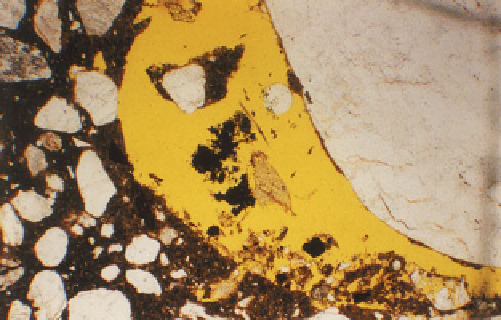Geoscience Reference
In-Depth Information
point-counting for air void analysis, alternative image
analysis techniques are being developed in an effort to
make modal analysis more efficient. From the volume
data, the original mix proportions (by weight) can be
calculated in a number of different ways. One approach
is detailed in Concrete Society TR No. 32 (1989) and
reproduced in St John
et al
. (1998).
Modal analysis is a suitable alternative to chemical
analysis methods for determining cement content and
aggregate grading, such BS 1881: Part 124 (British
Standards Institution, 1988). Modal analysis may be
preferable in circumstances where chemical analysis may
be subject to inaccuracies from the presence of acid-
soluble aggregate constituents (limestone etc.) or
chemically altered concrete (leaching and other
deleterious reactions). Experience to date suggests that
binder content determinations by modal analysis are of
comparable accuracy (or better) to chemical analysis
(Concrete Society, 1989).
particles at the upper surface. Trafficking in service had
caused the aggregate particles to collapse into the voids
giving the appearance of pop-outs at the surface.
The concrete ingredients must be adequately mixed
and unsegregated to ensure a uniform product. After
placing there is a tendency for the concrete to segregate
while in the plastic state, especially in poor-quality mixes
lacking cohesion. Workmanship factors, such as allowing
fresh concrete to flow along a form or excessive vibration,
will exacerbate segregation. Segregation manifests itself
in two main ways, which can both be identified and
assessed by petrographic examination. The first consists
of separation of coarse aggregate towards the bottom of
the form, which can be detected in core samples (
189
).
The second, which is characteristic of wet mixes, is the
bleeding of mix water (and cement grout) to the surface.
Bleeding can result in the formation of less durable,
highly microporous zones and bleeding channels.
Bleeding channels are readily observed in thin section
using fluorescence microscopy, owing to their tortuous
course (
190
) and associated enhanced microporosity (see
197
). An external manifestation of bleeding is the
deposition of a cement-rich laitance layer on the concrete
surface. As the laitance typically has a very high W/C, it
is porous, soft, and weak. When excessive laitance is
present on a concrete floor slab or pavement surface, it
may consequently be prone to dusting.
Adequate curing and finishing are crucial to the
production of durable concrete. The objectives of curing
are to prevent the loss of moisture and to control the
temperature of concrete for a period, to achieve the
W
ORKMANSHIP
General concrete workmanship issues that can be
assessed by petrographic examination include
compliance with specified mix proportions, the adequacy
of mixing, and effectiveness of placing, compaction,
curing, and finishing. A variety of specific workmanship
issues may need to be investigated as the result of a
perceived inadequacy of the finished concrete product.
For example, insufficient strength and durability
resulting from extra water being added to the mix at the
site can be checked for by assessing the W/C, using
fluorescence microscopy.
Although not a normal part of quality control of
concrete construction, it may become necessary to check
that the concrete ingredients and their mix proportions are
as specified. Such a requirement may arise if suspicions
have been raised regarding an unauthorized change of
materials, or from unsatisfactory concrete appearance or
performance. Petrographic examination can be used to
establish the type/source of the ingredients and the mix
proportions can be checked by modal analysis.
Once fresh concrete is placed, it is typically compacted
(by vibration) to eliminate entrapped air bubbles. This is
important as there is an inverse relationship between the
porosity and strength of concrete and the presence of
entrapped voids will reduce strength. The characteristics
of air voids and the assessment of compaction have been
discussed on p. 92. Durability issues can arise from air
voids that form beneath reinforcement bars or coarse
aggregate particles (as entrapped air voids or water
voids). Figure
188
shows a case of a concrete floor slab
where air voids had formed below coarse aggregate
188
188
Large air void (yellow) beneath a quartzite coarse
aggregate particle (white) that was the cause of
apparent 'pop-outs' on a concrete floor slab; PPT,
×35.





